16 May
A 6.30am flight from Heathrow made me decide to stay at a hotel overnight. I rose at 2.30am, had coffee and a bowl of porridge for breakfast. Sadly, hotel was at Terminal 4, flight was from Terminal 2, and I would have to leave too early to use the underground. So I paid for a taxi to take me, which at least meant I arrived directly at departures.
By 4am I was in the queue for self check in. I obtained my boarding passes and bag tag from a machine, then went to another machine to drop off my bag. Only 17.5kg, very light, but then I was going to a warm place rather than a cold one. I’d also decided to only take my lighter travel lenses, so even my backpack was small and light.
Flight to Istanbul was uneventful. I read a book I’d saved for the trip. Several hours between flights meant for a relaxing time in the airport. As airplane food seems to deteriorate year on year, or maybe I’m just getting less accepting of junk food, I ate something at the airport. At 3.55pm Turkish time I boarded the flight to Baku.
We landed in Baku at 8pm. By 8.25pm I’d cleared immigration and collected my bag. Very quick and smooth! One other person was being collected by the travel company, and we were driven to our hotel in Baku. My balcony offered a view of the grand building opposite. I had a shower, a bit of whisky (packed a bottle in my check in), and went to bed 11pm Azerbaijan time.
17 May
I’d opened the door to the balcony to let in fresh air. Sadly, this brought in unwelcome wildlife. I can be fast asleep, but the whine of a mosquito wakes me instantly. I did gain two bites in the night, but I also managed to kill the creature, finding its body on my pillow the next morning.
I rose at 7am. Before leaving the UK I’d established that Azerbaijan is very civilised in that hotel rooms have kettles. I was able to make coffee (I take coffee bags with me). No milk, but I can drink coffee black.
Breakfast was served from 8am. This was cereal and cold meats, cheeses, and salads, as well as crepes. I had two of the latter along with an apple and a coffee (this one with milk).
At 9am our group met as advised in the hotel lobby. Turned out there were seven of us, four men and three women. Our guide was there, and we set off for a walk through Baku.
Baku is an intriguing mixture of ancient and modern. During our walk, particularly in the old town, we visited centuries’ old caravanserai (where travellers stayed), several of which are now restaurants. We watched a woman cooking flatbreads in an urn, and our guide bought us some to try. Another guide gave us a tour of the Shirvanshahs’ Palace with its reconstructed throne room and burial chambers. The Soviet Union left its mark by adding its own symbols to ancient buildings.
Cats wandered everywhere in the old town. People put out water and food for the cats, sometimes signs nearby asking for donations. I also heard, and saw, ring-necked parakeets flying from tree to tree.
Lunch was in a restaurant looking over the Caspian Sea. The starters were hard cheeses with biscuits and honey, along with salad which, rather than being cut and mixed up, consisted of whole tomatoes and bunches of different herbs. A chicken dish with crepes and potatoes was followed by BBQ lamb and vegetables. Black tea with cherry jam (whole sweetened cherries in a sauce) finished off the meal.
Afterwards we clambered into our van and were taken to Highland Park. We also saw the graves honouring fallen soldiers and civilians who died in a uprising against the Soviets in 1990. An ‘eternal flame’ housed in a tall structure also bears witness. Of course people posed for photos behind the flames. The hill offered great views over the city and the Caspian Sea.
We walked down to the funicular, using it to drop down to the streets below. Returning to our van, we were driven out of the city. We had a brief stop to look at the outside of a mosque. A young boy on his bike took this opportunity to practise his English on us.
Our next stop was at the ‘fire-worshippers’ temple of Ateshgah. The buildings date back to the 17th century, and were built because of the natural flames caused by gas in the area. Hindu and Zoroastrians have used this as a place of worship. The natural flames ceased in 1969, due to the petroleum and gas extraction in the area, so now a piped gas supply keeps the flames going in the central altar and several smaller fires.
Destruction was caused by the Soviets using the various rooms for storage. These now hold displays, including grim details of how some supplicants wore chains and rested on hot platforms as a form of penitence.
The site was rather crowded. People posed near the main altar for photos. Our guide pointed out the ancient channels in the stone which had once brought gas to produce the flames.
Our last stop was at the Flame Mountain of Yanardag. Flammable gases seep through the hillside, erupting into flames. I must admit, I had expected a slope of flames, perhaps on some back country road. Of course, the area is designed for tourists, with seating and a gift shop. The flames were at the bottom of the hill, rather self-contained. Not quite the spectacle I’d anticipated. ‘More like a flame mole-hill,’ one of our group decided.
We went back to the city and had half an hour to freshen up for dinner. This was at a restaurant with views across the Caspian Sea to the city. The meal was similar to that at lunch. Salad, cheeses, wonderful bread (I consumed quite of a few of the breadsticks), and beef with vegetables and potatoes. I had a local beer, basically a lager.
Afterwards our van took us to a good viewpoint of the Flaming Towers. Various light displays light up the three modern buildings. We admired the sight before climbing back into our van to return to our hotel for the night.
18 May
No further bug bites in the night. Although I opened the patio door again, this time I ensured that the lace curtain was drawn across. Fresh air without the insects!
Woke up with a stiff neck and still feeling jet-lagged, so I had my usual coffee and a snack in my room rather than going down for breakfast. At 9am we assembled in the lobby and headed out with cases to our van.
Our first stop was at the Diri Baba Mausoleum. The original structure was built in 1402, and this plus the caves around the tomb have long been a site of pilgrimage for Sufis. We walked down the road to the base, admiring the very bright red poppies and other flowers along the way. I went up the main set of steps to the entrance. The last set of steps to go inside were very high and very narrow, so I peeped in rather than risk a fall. Hard hats and liability release forms were on a shelf nearby for those visiting the caves.
Going carefully back down, I spent time photographing the flowers and the impressive building. A nearby cemetery also drew my attention. Dogs, including a set of puppies, begged for food in the car park.
We visited a mosque, admiring the decoration inside. Our guide and I had a discussion about Islam, during which he explained that Islam gave equality to women, although sadly a number of Muslim countries didn’t recognise this.
A drive up a nearby hillside brought us to the Yeddi Gumbaz Mausoleum. The structures were built in the 18th century for the family of the last khan of Shamakhi. The site offered good views back down to the town and the mosque.
A discussion amongst the group about wine tasting made our guide offer that option. At our agreement, he had the travel office contact the vineyard at which we were meant to have lunch anyway. A wine tour and tasting was arranged, at no cost to ourselves.
The wine brand name is Meysari. The vineyard was planted in 2015, using French grape varietals. The complex offers extensive grounds, including a lake, and a hotel is being built on the nearby mountain. A cable car system will connect the hotel with the restaurant complex.
We were taken into the winery, where we admired the huge metal vats. ‘Fifty six vats, we have,’ said the vineyard guide. As I’ve often heard Azerbaijani speak in this fashion, I have come to the conclusion that Yoda must from Azerbaijan have come.
After the fulsome tour, which included the bottling area, we had our wine tasting. Three bottles were opened for our group of seven, a white, a rose, and a red. We had various snacks to pair with the wine, such as olives with the white and dried fruit with the rose. A salty cracker was paired with the red.
At lunch afterwards we ordered more red wine to drink with the food. The lunch followed the usual pattern of nibbles (salad and cheeses) followed by soup and a beef dish.
Perhaps unsurprisingly, a number of us napped on the two hour drive to Lahic. The drive through the mountains provided great views. The ancient town is set just up from a river, with cobbled streets and many shops selling the usual tourist souvenirs. A few also offered the metal work, in particular copper, which the area is known for. We stopped for a cup of tea and watched men building a wall. At our request, one family allowed us to go through a gate to walk down the alley way to their house. A hen with around a dozen chicks fluttered nearby.
We returned to the van, passing several men who offered us the opportunity to be photographed on their horses. None of us were interested. Two boys were puling branches from a tree to feed their donkey.
The road to our final destination was under construction, so it was a slow drive on the unpaved road. We arrived at our hotel at 8pm, pausing only to dump cases into our rooms before reporting to the restaurant. The live music made us wince, but we tucked into the usual salad offerings, this time including a very nice beetroot concoction. We thought the chicken patties and french fries were our main course, so we were rather full when the BBQ meat and vegetables arrived. We’ve now asked our guide to be informed, at future meals, as to how many courses to expect so we can pace ourselves accordingly.
19 May
A shorter driving day. We headed off at 9am to visit a couple of Albanian churches in the Gabala region, both several hundred years old. The women were asked to wear a head covering to go inside, something about which I have mixed feelings. Yes, I guess it’s showing respect, but on the other hand it’s also marking some form of difference between men and women which makes me feel uncomfortable.
The first church, dedicated to the Virgin Mary, was plain inside, made of brick, and we were the only visitors during our time there. A plaque with writing was propped up by the altar. It was in a language not known to our guide, but the pattern made me suspect it was the Lord’s Prayer. (At another church, later on, we discovered that this was indeed the case.)
The next church, St Elisey, was set in large grounds, with a baptismal font outside. The descendants of the man who had built it still look after the area, and we encountered several members. One, a woman, married an American and lives in Florida. She was able to tell us about the church. There was a bit of a clash between her and the American member of our group. They were obviously on different ends of the political spectrum.
Throughout the last couple of days we’d seen roadside stalls selling tea and bread, with picnic tables set up nearby. We stopped at one, watching the women cook the bread (in large clay urns) before having a cup of black tea and thyme. Alongside this we ate some of the bread and cheese made by the local family. Cats, chickens, and a small turkey wandered around the area.
We drove on to the ancient town of Sheki. There we visited the fortress, and in particular the shah’s palace. No photography was allowed inside, so we simply admired the ornate stained glass windows, the painted walls, and the clever ventilation system. Our guide explained the symbolic use of lions, dragons, and peacocks. One room had a wonderful frieze of hunting and battle scenes.
Muslim tradition forbids the depiction of humans or animals in decoration, so the shah had also arranged for a confession to painted alongside the art, asking Allah’s forgiveness.
Nearby was a workshop specialising in the local stained glass. The glass is cut out and inserted into wooden frames, and one of the artists demonstrated the assembly process. He also made storage boxes from which the trays moved out when turning the top. I admired the box, but the price was a bit beyond my budget at around £180. I did buy one of the small stained glass items.
We continued our walk in the bright sunshine down the hill into the town. At a large caravanserai, we had time to admire the large courtyard and the rooms leading off. Lunch was at a nearby restaurant. Similar to previous meals with salads, soup, a chicken dish, and then a BBQ platter.
Our final visit was to Kish, to visit the old Albanian church there. The site was a place of worship even before Christianity. Items found buried beneath the altar date back to 3000 BCE, and the current building was erected in the 12th century. The church is now a museum, so no need for women to cover their heads.
We went on to our hotel, arriving around 4.30pm. My balcony provided a nice view of the nearby mountains. After several long days of sightseeing, it was nice to have a relaxing afternoon during which I caught up on processing my photographs.
Dinner was in the hotel restaurant. A birthday celebration was underway, with around twenty women (no men) seated at a long table. Well, seated when they weren’t up and dancing to what I assume was traditional music. We ordered meals from a menu. I had the chicken kiev, which turned out to be solid meat all the way through (rather than having a hollow centre filled with garlic butter).
20 May
The bird song was lovely when I woke up at 4am. I went back to sleep shortly afterwards.
We set off on a grey, overcast day and drove a couple of hours to reach Mingachevir. The city was founded in 1945 and the fourth largest city in Azerbaijan. After being taken past the Kura hydroelectric power staton (largest in the country and supplies 75% of the country’s electricity, and as a result is protected with military firepower), we drove down to the lakeside for a brief stop. Although abandoned picnic tables sat on the beach, litter covered the sand. Goats and sheep grazed near a series of dilapidated boats, their shepherd paying more attention to his mobile phone than the flock.
At the river, we took a boat ride which did a small circuit and lasted all of fifteen minutes. Afterwards, we had a coffee break. The drinks took thirty minutes to arrive, but at least it was a pleasant setting, looking out over the river. We saw seagulls, cormorants, egrets, and ducks fly past.
The van took us on a bridge across the river for our lunch. Again we sat outside, enjoying pike (fried or grilled). Very tasty. Again it took awhile for the food to be served. A cat begged at our table, placing paws near our elbows to emphasise the point. We did share out some of our fish.
Then a drive to Ganja. During the day, our guide told us more of his personal story. Like most young people, he was required to serve eighteen months in the military. He was trained as a sniper, and after too many hours staring through a rifle scope, his right eye has suffered permanent damage. In addition, the cold winter conditions has caused kidney damage, and indeed he had been in considerable pain yesterday.
We saw the impact of the conflict with Armenia throughout the day. Posters of dead soldiers were set up along the roadside and on walls in the cities. We visited a mosque, and in the upstairs section huge panels displayed photos and names of the war dead.
The mosque was also noteworthy that a modern building shielded an older structure, within which was a tomb. Pilgrims walked counter-clockwise around the tomb. Our guide explained that this wasn’t part of Islam, and he felt those undertaking the rite weren’t truly Muslims as a result. Swallows flew around inside, having made nests in the building. Bird poo and several dead bodies marked steps and carpets. It seems it’s considered bad luck to try to evict them, but I did feel for the caretakers who looked to have given up on keeping the mosque clean inside. It reminded me of the damage bats do to churches in the UK.
Upon arriving in the city of Ganja, Azerbaijan’s second largest city, we went to the local bazaar. Fruit, vegetables, herbs, and cheese were on sale. We spent a few minutes wandering through, admiring the displays.
Further along we stopped to view the Bottle House. This was built in 1966-1967 using around 48,000 glass bottles. The builder constructed it in memory of his brother, who went missing during World War II. According to our guide, the builder hoped that the attention paid to his creation might lead to his brother being found. This sadly did not happen.
We went on to a local Russian Orthodox Church. Our guide warned us that the woman inside was usually bad tempered and it would be unlikely that we’d be allowed to take photos. If we bought candles this might change. I decided to buy a candle, and I lit it for the adult child of someone on the tour. Her child was due to have an operation on the Friday.
The woman in the church allowed us to take photos, going so far as to insist on taking one of me inside the church. Success all around. Rather amusingly, it seems our driver hadn’t been aware of the possible injunction, and had been merrily taking photos throughout our visit.
Our last stop was in Fountain Square. We admired the theatre, which had been a synagogue in a previous life. We visited the nearby mosque, which was rather lovely in its simplicity inside. Then our van took us to the hotel, where we had our dinner. More cats wandered into our room and again a number of us offered them meat from our dishes.
The day, the group agreed, had been a bit of an odd one, with the drive past the hydroelectric plant, the rubbish covered beach, and the bizarre short river cruise. There was also some mosque exhaustion.
21 May
Back to sunshine. And our long drive south-east to return to Baku.
The first couple of hours passed quite well, our van charging down the motorway. We had a pit stop at a rather unattractive service area. Our guide had us climb back on board to stop at a much nicer cafe down the road. I was delighted to find a tiny praying mantis climbing on one of my group members. I rescued her and admired her delicate beauty for a few minutes before placing her safely on the grass. She easily fit on top of my fingernail. I’d never encountered one so small before.
As we continued our journey, the van suddenly made a strange noise. We pulled over to the side of the road, where the driver and guide had a look. Something had snapped. We continued a little further, another pull over. The diagnosis was the alternator belt, which meant we could continue with caution.
At a much slower pace we drove to Gobustan. This site preserves a multitude of rock engravings, perhaps over 6000 in total, carved at different times and dating back 40,000 years. A local guide took us around the rocky, rather windswept area, showing us the engravings. We walked into caves, watching as a pair of birds nesting above us had a discussion. I later identified them as juvenile Red-billed choughs.
The area was quite high up, providing views over the dry landscape below. The guide showed us holes in the rocks, used for storage, animal sacrifice, and cooking. Another large, hollowed out stone was used, it is thought, to provide music. She hammered the sides with smaller stones to demonstrate this for us.
Several lizards made appearances, but none of the local snakes. More choughs hopped between the large rocks.
We were taken back down to the entrance, where a mechanic was waiting to deal with the van. The local guide took us around the museum, which had displays about the petroglyphs and the people who would have lived in the area.
When we’d finished, the van was still in no state to take us anywhere. It had been driven to the edge of the car park, where a drop down to a small seating area allowed the mechanic to crawl underneath. He seemed to have another mechanic with him, and the driver also wandered around with various fan belts in his hands. Our guide joined them, and it appeared he was showing them YouTube videos on what they needed to do.
We sat in the shade and our guide paid for drinks and ice creams. The wind started to pick up, becoming quite fierce. Also fierce was our guide. He explained several times that he was not in charge of the company which provided the van and driver, and relied upon them to ensure that the vehicle was in a fit state.
As the wind increased even further, we took shelter in a nearby cabin. Although there was no cafe as such, a woman was offering flat bread, with a topping of either herbs or meat. We had a few of those as our late lunch.
Finally, two hours later the van was repaired. We drove along to the mud volcanoes. Because of increased tourism, the area was recently civilised with two museums and a walkway past the nearest mud volcanoes. We visited the first museum, which featured a rock collection and information about the volcanoes, before venturing out on to the walkways. I braced myself on the platform whilst attempting to capture mud bubbles. At some points I was worried that the strong gusts which actually blow me over.
Although undoubtedly the infrastructure has made the area safer for visitors, it did seem a bit tamed down and controlled. After some more photos, I joined the others in the second museum. This featured a large collection of animal skeletons, as well as whole animals preserved in jars. A bit of a bizarre experience, really.
Back to the van and our drive to Baku. We returned to the hotel we’d used at the start of our holiday, having a 45 minute break before meeting up to go to a local restaurant. Our guide paid for us to have red wine with our dinner, still apologetic about the time it had taken to repair the van. Afterwards we stopped at a coffee shop for drinks before returning to the hotel for the night.
22 May
The wonders of air conditioning. I decided to use it and slept very well, as I prefer a cold room at night.
Our last full day in Baku took us first to the History Museum. A guide there took us through the many rooms, outlining the history of Azerbaijan. Many exhibits filled the cabinets, with very good English translations. The building which houses the museum was once the residence of a wealthy family, and the upper rooms have been restored with furniture and decorations.
The tour took around two hours. Afterwards our van took us to the Heydar Aliyev Center. Sadly, renovation works spoiled somewhat the outside views of the flowing walls. Areas inside showed off modern art, including an installation which blew silk scarves into the air. I wasn’t very impressed with the large chillies and vegetables, but I did like an exhibition of metal sculptures, rather fantasy like humans on horses (and a unicorn).
On to lunch, again more food than we could deal with. After a cup of tea, the group split. Some went to look around the city. I headed back to the hotel, preparing myself for my early start at 4.30am the next day. I was the only one in the group taking the optional extension to Nakhchivan, and I’d already arranged that my main bag would be left at an airport hotel. I’d only take carry on to make life easier.
Our evening meal was at a ‘museum restaurant’. The multilevel, large complex had various rooms filled with Azerbaijani artefacts. Several were Soviet Union themed, others nodded to the Silk Road. We had salads and king pilaf (rice with meat and apricots cooked in a pastry shell) whilst traditional music was sung and played. Several people in costume danced from time to time, often joined by members of the public. Bearing in mind my upcoming early rise, I stuck to soft drinks.
Back at the hotel, I said my farewells to the group and went to my room for an early night.
23 May
My phone went off at 1.30am, my mother wanting to talk to me. I explained the lateness of the hour and asked if I could phone her when I was back in the UK.
My alarm went off at 3.30pm. I had taken up fruit from the breakfast offerings the day before, and I ate this alongside a breakfast bar and coffee. At 4.30am I met my driver in the lobby. My big case was handed over to the airport hotel, and by 5am I was at the check in desk.
Security insisted that I had to put my belt through the scanner, even though the belt had no metal parts (the buckle is plastic). I tried to explain that I could not remove the belt. The buckle is actually almost too large for the loops, and it had taken me a good few minutes to thread it through some years ago and I’ve found it impossible to remove since. The woman was adamant, so in the end I stripped off my trousers and walked through the scanner wearing shirt and underwear.
I had a coffee and bought a bottle of water at the small cafe. The domestic airport at Baku had only three gates and these were adjacent to each other. Free wifi kept me amused until it was time to board. The plane was full, despite the fact that multiple flights went to Nakhchivan during the day.
A fifty minute flight over other countries (Nakhchivan is separated from the rest of Azerbaijan by Armenia) brought us to the city of Nakhchivan. My guide collected me from the arrivals area. He turned out to be a 20 year old university student, who got into offering tours because he has dedicated himself to learning English. His command of the language was very good, but he was eager for me to offer any corrections during the day.
We climbed into a car and the driver took us out of the city. Our first destination was Alinja Fortress. The original was built in the 12th century, at 1698 metres on a mountain peak. After being conquered and destroyed several times, the government recently restored the area and built the 1600 steps which leads up to the fortress.
I’d already made contact with my guide the day before (on WhatsApp) and we’d agreed to take the easier option of a ride in a Lada to the half way point. The guide cheerfully told me that 70% of his clients go for this option. The distance to the top still looked daunting when we exited the car, but at least the climb was still in shade. A breeze also helped to keep us cool.
We started the trudge. I took breaks as necessary. To our great delight, we came across a mountain goat. He climbed up part of the path and then around the side of the mountain, sure-footed on the steep slopes. We also saw several varieties of lizards and birds.
Once we reached the fortress complex, I took time for photos and to catch my breath. Another set of steps, a bit trickier, led to the view point over the fortress and its setting. My guide explained how he and his father, when he was a boy, had climbed up to the fortress from their village nearby. There were no steps in those days. The government would like to put in a cable car system to take people up, but so far logistics and finance have proven difficult. There was no entrance fee, not even an honesty box to ask for donations.
The Lada was one way only. We went down the 1600 steps. My guide offered breaks, but when I stopped, I found my calves spasming. It seemed better to keep going. I’d brought a walking stick with me, and this proved helpful.
It was good to enter the car. Our next site was only a short drive away, a building where Sufis can meet and worship. I admired it from a bench in the shade, as it had taken a set of steps to get that far.
A slightly longer drive took us to the Ashabu-Kahf Caves. Several legends belong to the site. The Muslim tradition is that the Seven Companions took refuge in the cave to escape persecution from the Roman Emperor Decius. They fell asleep for 309 years, emerging unaged.
Another set of steps upon steps upon steps. We watched people go around a stone counter-clockwise three times for luck. At one point I halted to allow my knees to recover. An elderly woman spoke to the guide and, upon hearing that I was tired from the fortress climb, seems asked Allah to give me healing. She also advised us to ‘look up to see the angel’ when we arrived in the mosque area.
Urged on by the guide, I clambered up to said area. Looking up at the steep cliffs, the opening did indeed appear in the shape of an angel. Goldfinches darted past. I also discovered that my guide used to have budgies as pets. Sadly these escaped due to his mother leaving windows open in the house. I showed him a photo of my beloved parrot, Tilly.
Near one of the small mosques was a meteorite set in a metal cage. As instructed, I walked around it three times counterclockwise, my right hand on the smooth black stone the entire time. It’s supposed to give luck. I would have preferred new knees.
My guide suggested we go further up, to a cave in which we could sit ‘and if water drops on you, that’s good luck.’ As there was so sign of these new knees, I declined. I’ve been dripped on in caves before.
We drove back to the city and had a nice outdoor lunch. I had BBQ beef and chicken with a salad. The usual cats wandered around, looking for food, and I obliged.
The day had heated up, reaching around 30C. We visited the Nakhchivan fortress, popping into a small museum to view clay pots and tomb stones from the area. Another set of steps led to a view point over the city. By this time I was beginning to tease my guide, who kept promising ‘No more steps’ and then finding yet more for me to climb.
Nearby was Noah’s Tomb (or one of the places claimed for him). We’d seen Mount Ararat earlier in the day. We walked on to the Heydar Aliyev Mosque, the largest in the Caucasus and which can hold 5000 worshippers at at time. We took our shoes off to go inside, and my guide assured me it was okay that I didn’t have a headscarf with me. As it happened, we didn’t see anyone else during our time in the mosque.
A walk through a city park brought us to the Momina Khatun Memorial, built in 1186 by a king in honour of his wife. Nearby was a collection of stone animal sculptures, collected from around the region, some dating back to the eleventh century.
We went through a small artists’ area, selling goods in a long building, before visiting the Khans’ Palace. This was built in 1760, and the rooms featured furniture, paintings, and stained glass windows. The woman staffing the palace asked my permission to take a photo of me to put on to social media. A bit puzzled as to why I should merit such a mention, I agreed, and struck a pose.
I asked if the car could come to meet us rather than walk all the way back through the park. We drove out of the city for our final destination, the Duzdaq salt mine caves. Salt has been harvested underground in the area since the third millennium BCE. In 1979 work was completed to turn the caves into a health spa. It’s believed that staying for awhile in the caves (up to two nights can be booked) provides relief from asthma and other breathing difficulties. This is due to the sodium and chloride ions. The smell was rather unique, a bit like iodine and a lot like nothing else I’ve ever encountered before.
The temperature was nice and cool after being outside. This remains steady around 18-20C. We walked down the long path, the salt walls glistening around us. For awhile we sat and talked on a bench, wondering how to power a world when windmills and solar panels don’t seem to provide the answer.
I was dropped off at my hotel, where I was very pleased to go to my room and have a shower. During the day I’d become sweatier and sweatier, but so had my guide so I felt I probably hadn’t offended his nostrils.
At 7.30pm I was collected by another person and taken to a restaurant for dinner. We sat outside and he talked about his hopes for tourism in the area. I also asked how the governing of Nakhchivan works (sounds similar to the devolved governments in Wales and Scotland). After I’d finished, I asked to be taken to the hotel. It had been a very long day!
24 May
Perhaps unsurprisingly, I developed a neck ache during the night. Several bouts of ibuprofen brought this under control by the time I headed up for breakfast. The hotel’s restaurant offered good views over the city.
At 9am I met the same driver but new guide in the lobby. Well, I say guide, but during the day it became obvious that she was really just a translator. Her English was pretty good but not as developed as the chap from the day before, even though she was studying the language at university. Yes, I had another student with me for the day.
We drove an hour for our first stop, at the Jahan Kudi Khatun monument. This was built in the 14th century and looks like a mosque, with twin minarets. A mausoleum is situated nearby. We waited for keys to be brought to allow us into both buildings. The main building is now a museum, featuring the usual items of local finds, such as jars, bowls, and other household implements.
I asked how long the drive would be to Ordubad, which was described as a medieval town and therefore of interest to me. ‘Two hours’ was the answer, which surprised me as the notes given to me stated that Ordubad was 70 kilometres from Nakhchivan and the roads looked to be in good condition.
The reason for the time became evident. Our driver seemed determined to drive slowly, often far under the speed limit (I noted the signs as we drove along). Other cars regularly passed us. I was also rather concerned about the driver, as he often seemed to shake his head for no reason and rub his face. Later in the afternoon the translator explained that he’d been working two days straight with little sleep, which probably explained his state. Although both yesterday’s guide and today’s translator had not used their seatbelts, I decided to use mine.
The countryside was very dry, mountains increasing in height as we headed south. Soon we were skirting the border with Iran, passing a customs area.
Around noon we arrived at Ordubad. We ended up in the old town, the street only just wide enough for our car. Several times we stopped and the driver seemed to be asking for directions. Eventually we found our way to the main part of the town.
My translator took me to two buildings. The first was the Geysariyya museum, next was the Juma Mosque, both dating back to the 17th century. As yesterday, when we went into the mosque, it didn’t matter that I (nor she) was wearing a head covering. ‘We’re going in to visit, not to pray,’ she told me.
After this we ate lunch, sitting outside and looking down into a gorge. I had the usual BBQ meat with salad. I was a bit nervous about time, as my translator had said it could take two to three hours to drive to the airport from Ordubad. She was certain that I’d only need an hour to check in and go through security, but I wanted 90 minutes just to make sure.
I asked what we were going to see in the afternoon, and was told ‘museums’. Somehow I had assumed that this would include time to view the medieval part of Ordubad. Only when we had left the town behind did I realise that this was not going to happen.
On the way back to Nakhchivan we stopped at the Daridag Thermal Spring and Gulustan Mausoleum. Both were worth the ten minutes we spent at each. The mausoleum was at the border with Iran, and we had to summon a soldier who contacted someone else for permission before he let us through the gate.
Daridag is a spa, offering people the opportunity to enter a pool filled with water from a natural hot spring. After going inside the facility to have a quick look at the pool (a very hot and humid room!), we went outside to see the pipework which brings the water to the facility. A hotel complex is being built nearby.
Gulustan mausoleum was built in the thirteen century. The wire fence which marks the border with Iran was just 100 metres away in several directions. I thought longingly about trying to put foot through to be able to say that I’d been in Iran, but I didn’t want to alarm any soldiers from either side.
We continued our journey back to Nakhchivan, arriving in the city around 3pm. Staff sprang to attention as we entered the History Museum. One took us around, explaining the exhibits in Azerbaijani. I gave up asking the translator for, well, translation, something she didn’t seem inclined to offer without prompting and when I did ask, gave me little more than I could read on the English descriptions alongside the artefacts.
A second person followed us. When I asked why, I was told that this was policy, visitors to the museum needed to be followed. I could see that this woman was trying surreptitiously to take a photo of me, so I told her (via translator) that she only needed to ask. Which she did. As yesterday, she wanted a photo of me in the museum for their social media accounts.
The exhibits spanned the history of the area, from Stone Age people (with paintings depicting hunting parties) to Soviet Union times. Household implements, jewellery, fossils, bowls, swords, and guns hung on walls and hunkered in display cases. Lots of paintings illustrated historical events, some realistic, others far more modern with glaring colours and flowing lines.
Our last visit was to what the translator expected to be a carpet museum. When we entered, it was obvious that this was a collection of photos and personal belongings from dead soldiers. She’d taken me to the wrong building. However, I was happy enough to skip the carpet museum.
We headed to a restaurant so I could have something to eat before going to the airport. I had a Caesar salad and an iced coffee. Driver and translator sat at the table with me but declined to eat or drink anything themselves. I made conversation by asking the translator what she wanted to do after finishing her degree. She has plans to do a Master’s somewhere in Europe, such as Italy, Germany, or the Netherlands. Once she’s done that, her hope is to work in a company as a translator, and definitely somewhere in mainland Europe. She doesn’t want to live in Azerbaijan as she believes that mainland Europe is far more modern and would offer a better life for her.
After I’d finished eating, I asked to be taken to the airport. My translator said it was far too early, but I reminded her that I wanted 90 minutes. We arrived just after 5pm, where I said my goodbyes.
It did only take a few minutes to check in. I went through security, and this time I wasn’t even asked if I were wearing a belt, so I went through the scanner still in trousers. I was asked if I had any cigarettes, which of course I didn’t, so I really don’t know where that question came from. I didn’t have any matches or a lighter in my bags.
I took a seat in the departure area for the gate and wondered about the strange day I’d had. It seemed a long way to drive to Ordubad just to see two buildings and have lunch. I would have liked to see the medieval town, as I thought that was the reason to go there. Had I known we were heading out, I would have spoken up. I also missed the guide I’d had the day before, who knew so much and was very chatty.
After an hour in the air we landed in Baku. I was pleased to stroll past the luggage collection area, smug with just my carry on. I’d been booked into a hotel near the airport and, as promised, a car was waiting to take me the five minute drive to my accommodation. I collected my bag, booked a 2.30am wake up call and 3.30am trip to the airport, before going to my room and having an early night.
25 May
A tiring but uneventful trip home. Back to the airport at 3.30am, catching first a flight to Istanbul and then on to Heathrow. By 3pm I was home and unpacking my bag. Holiday over!
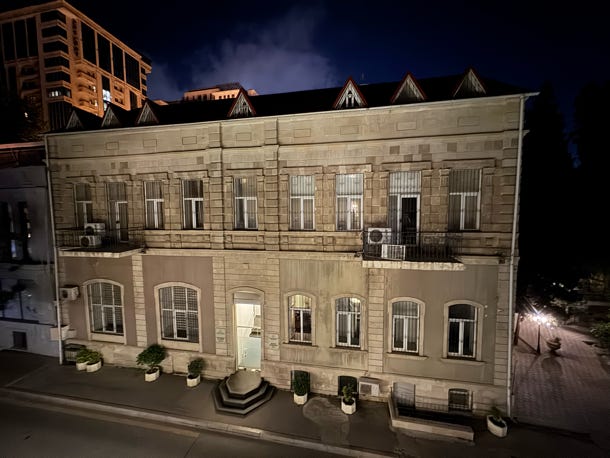
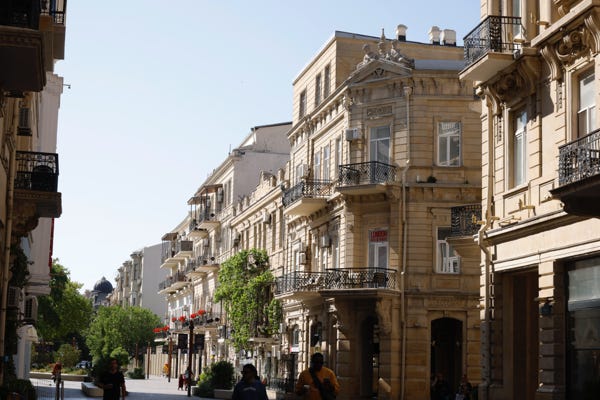
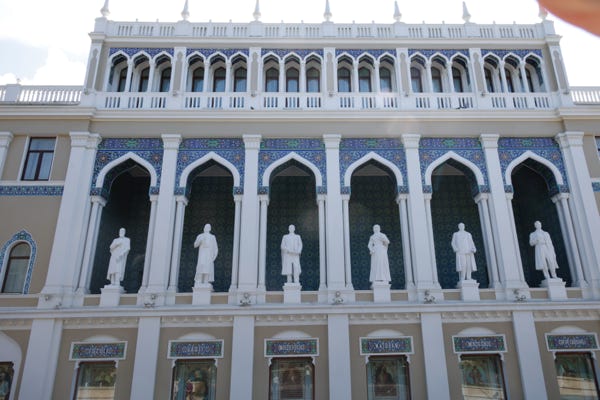
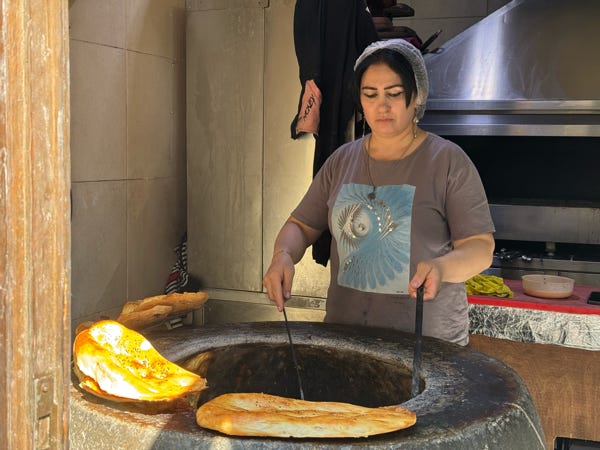
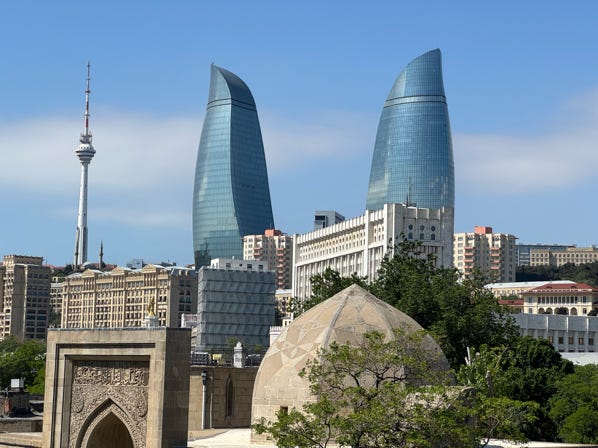
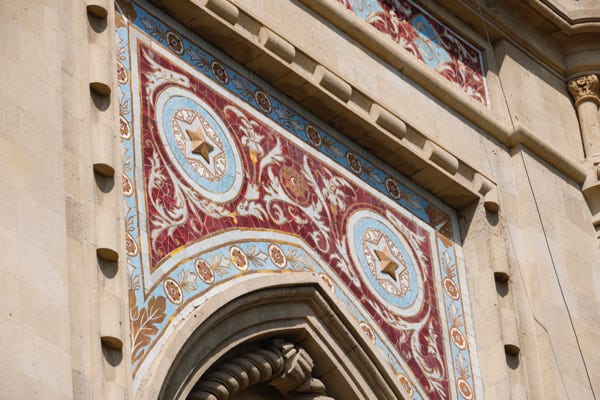
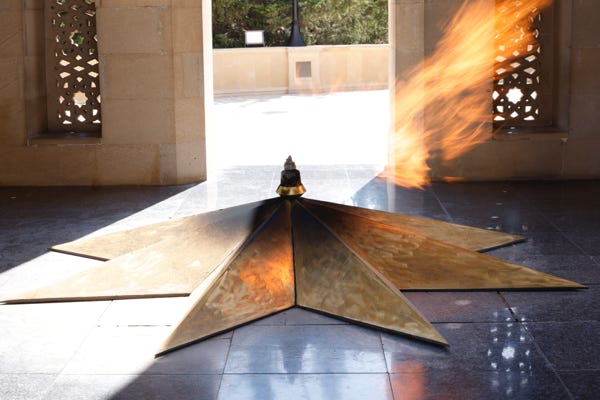
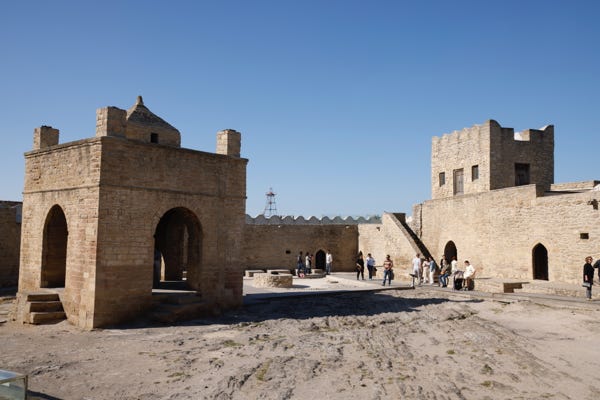
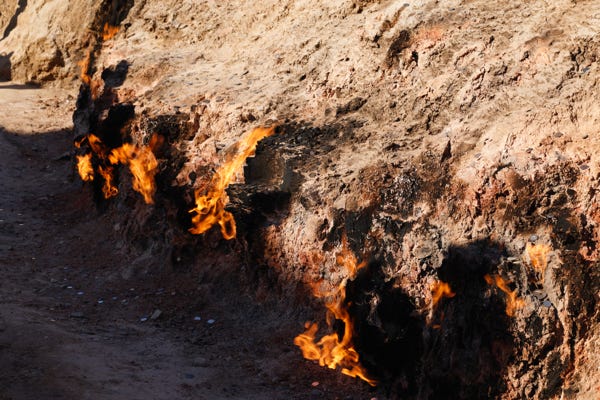
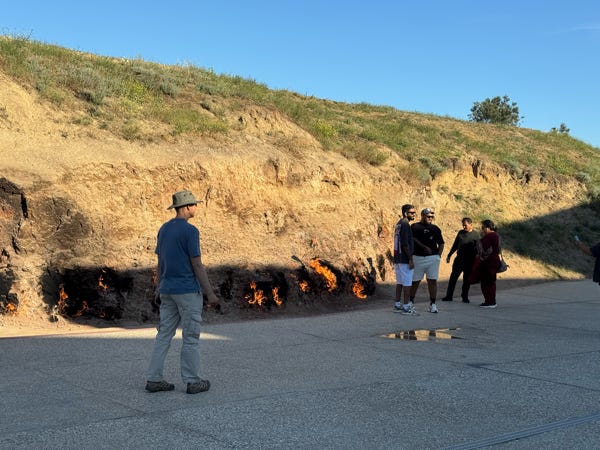
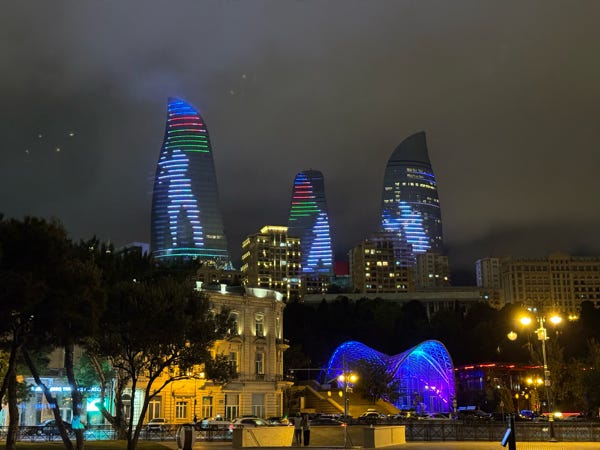
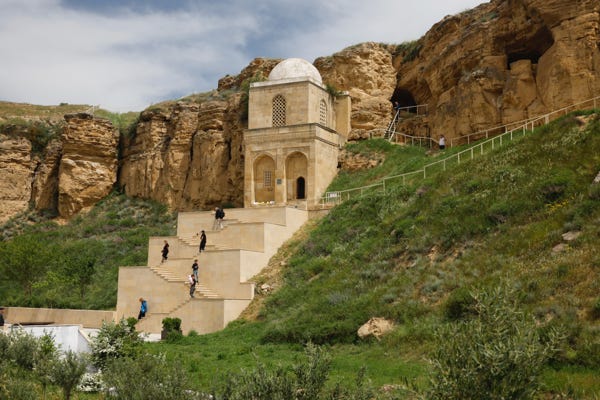
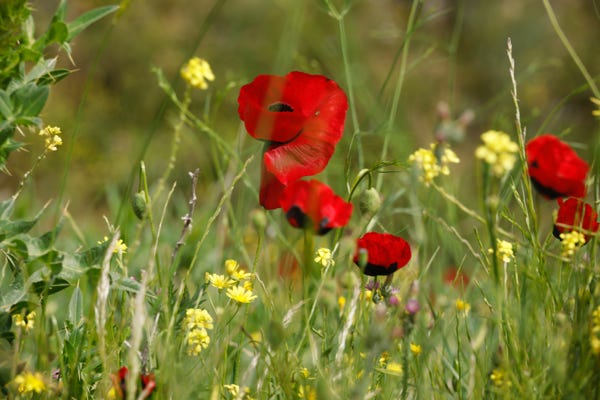
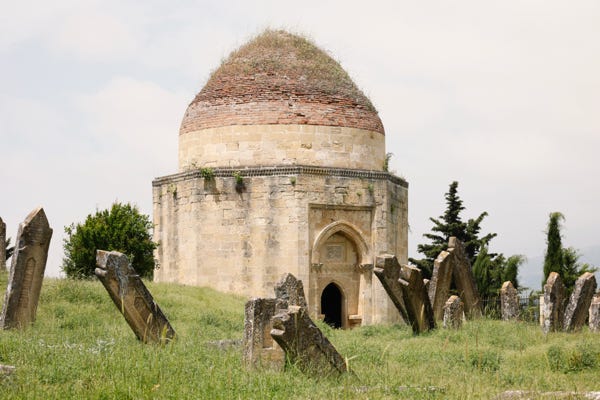
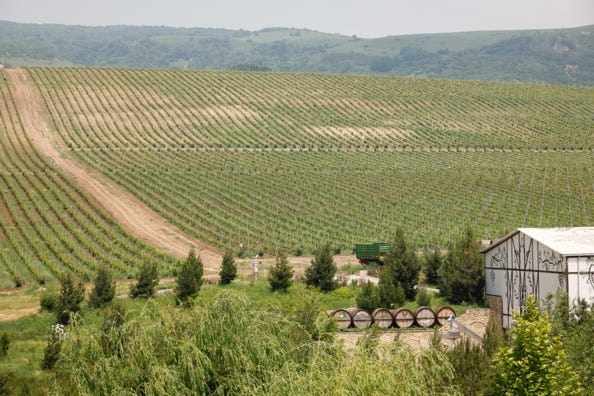
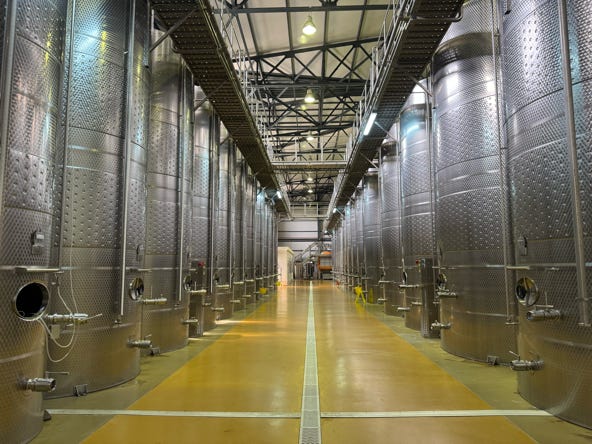
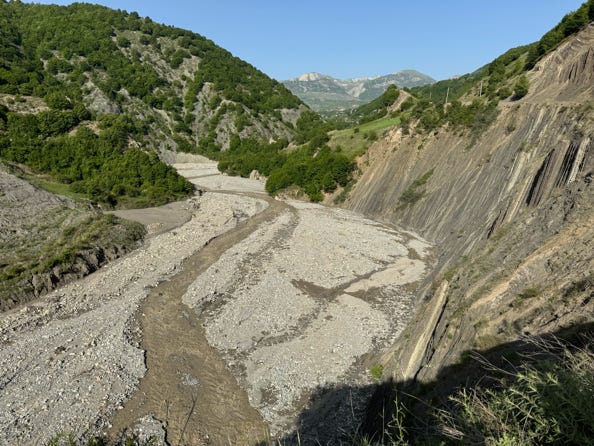
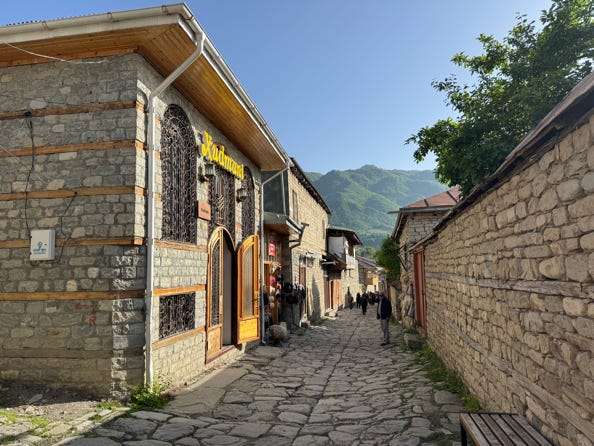
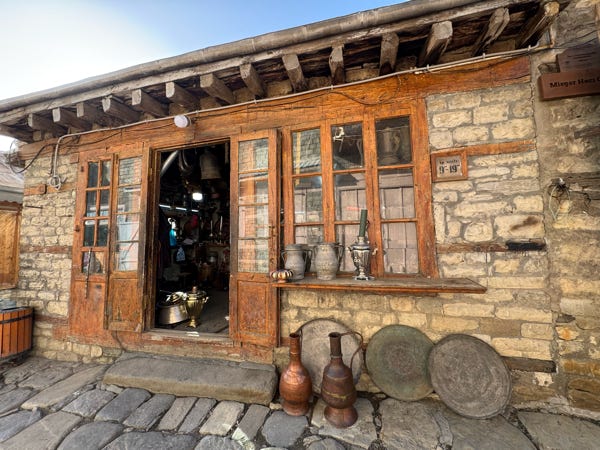
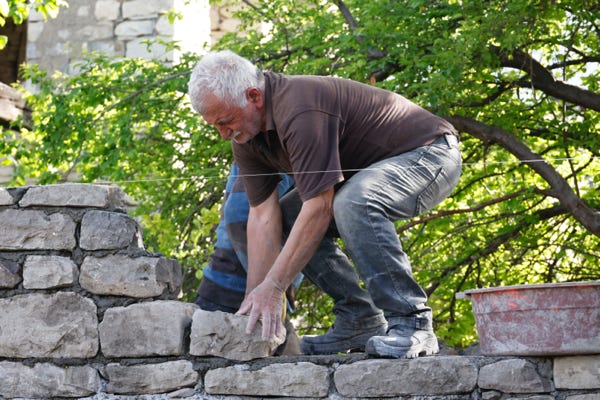
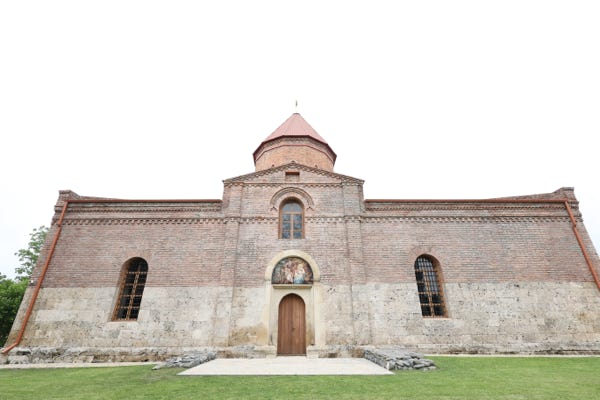
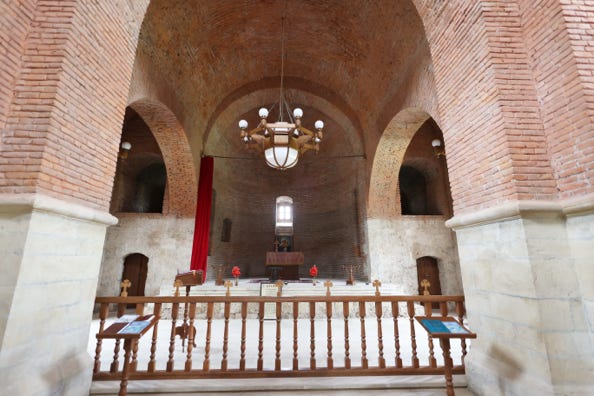
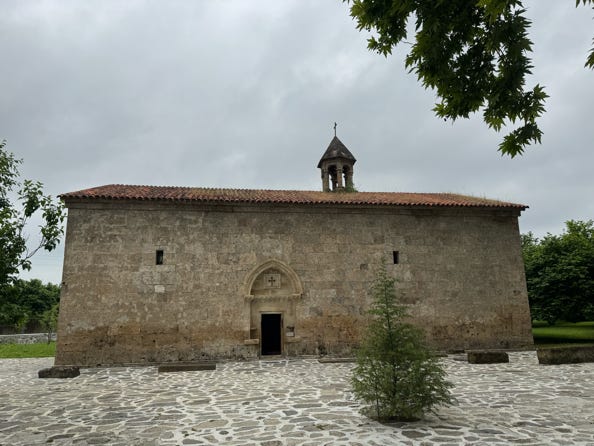
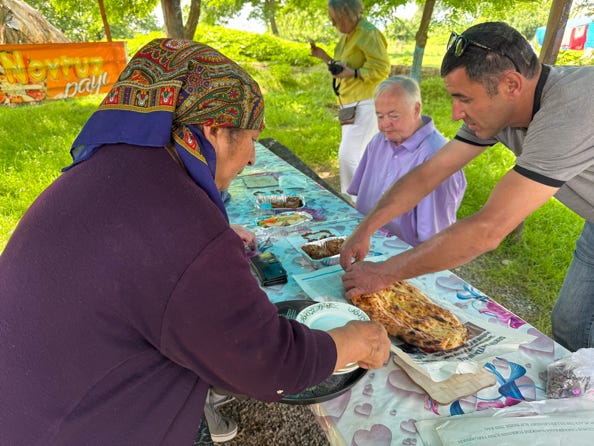
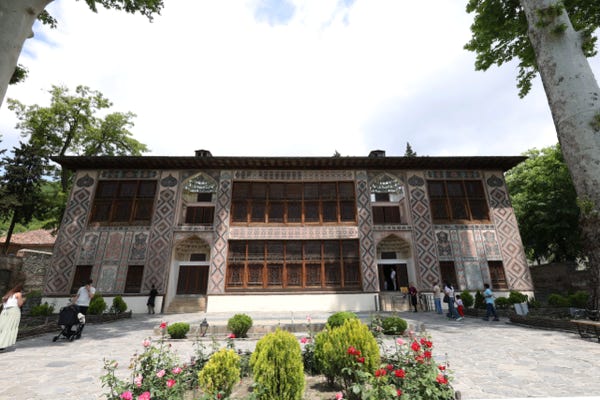
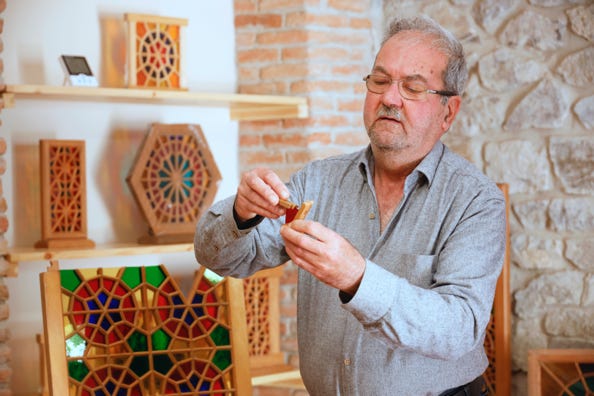
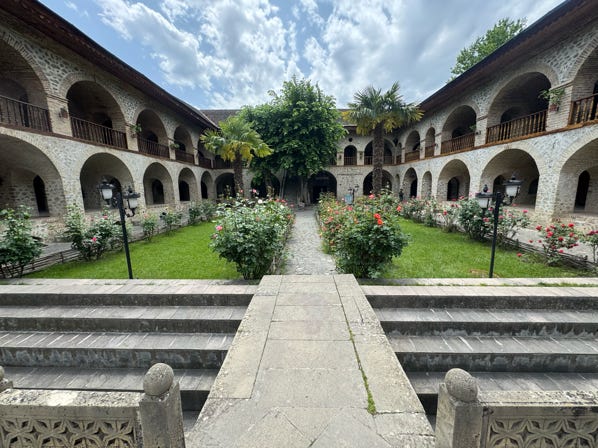
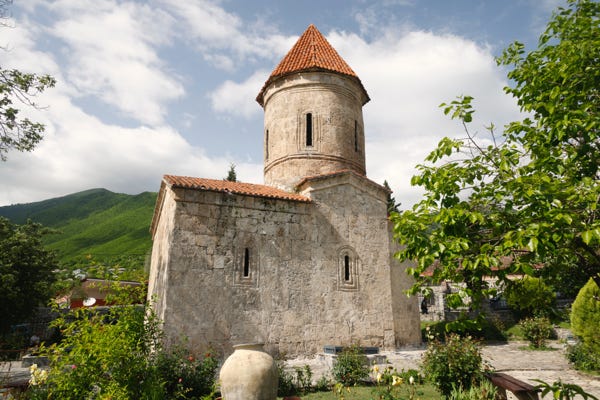
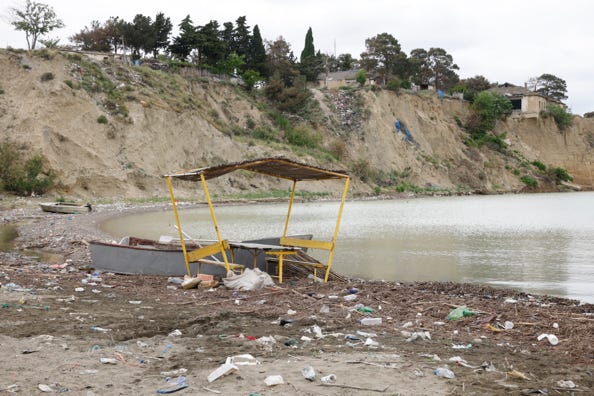
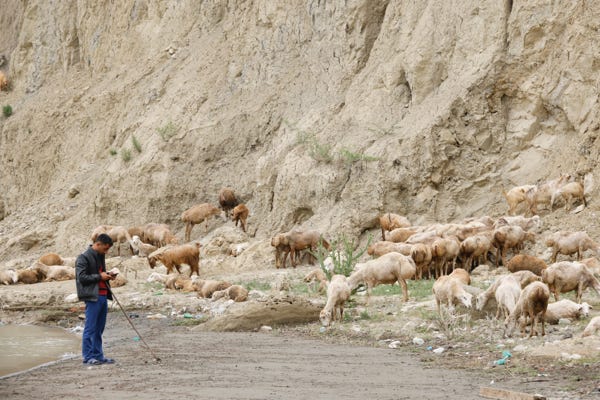
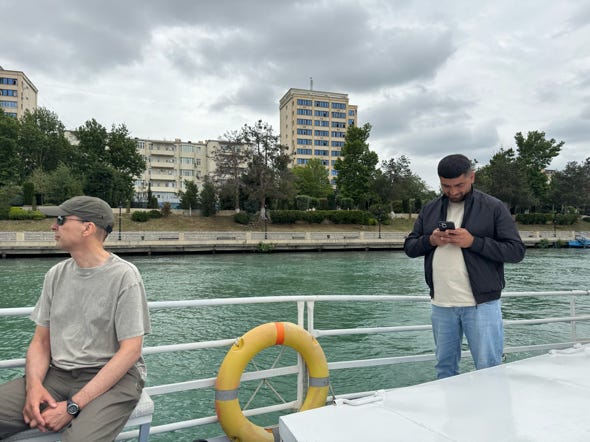
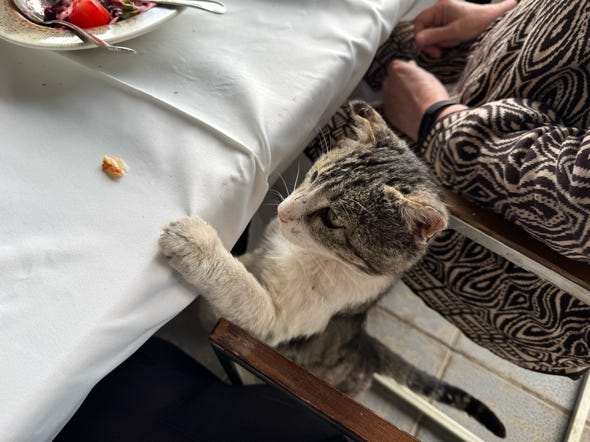
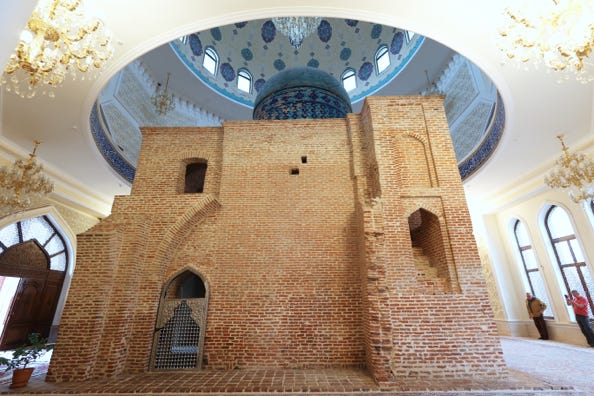
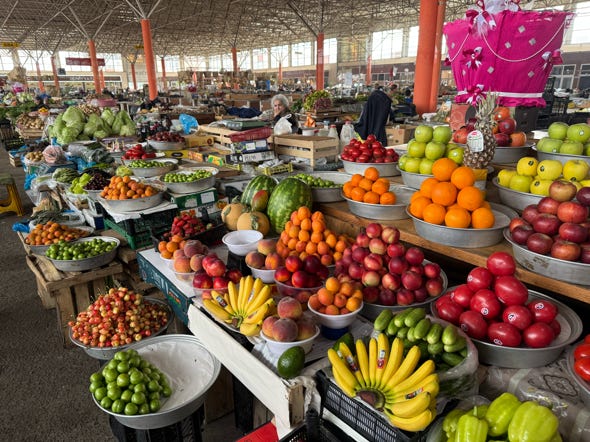
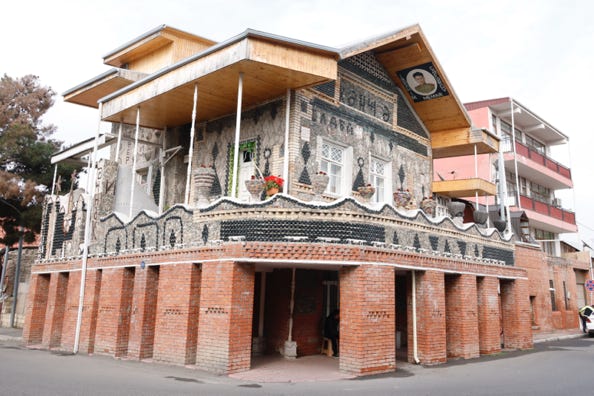
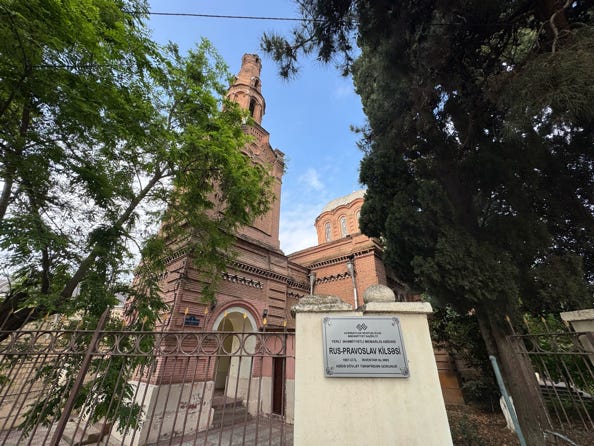
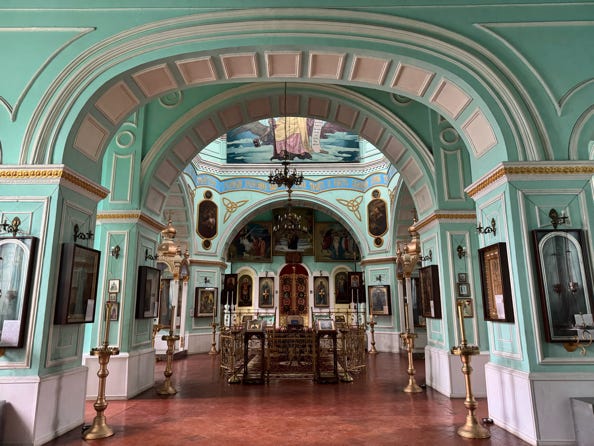
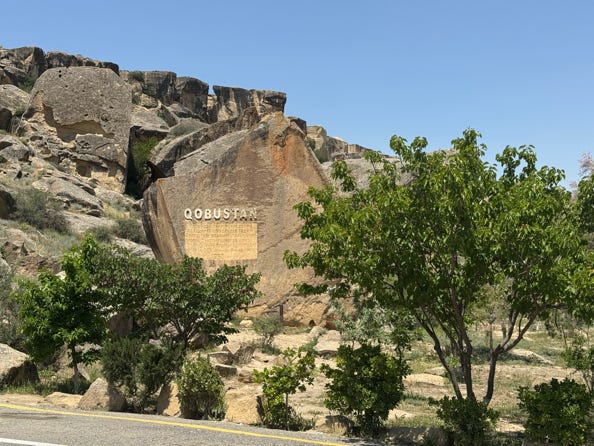
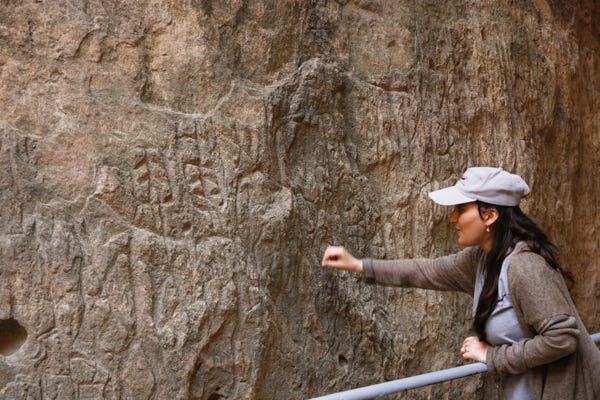
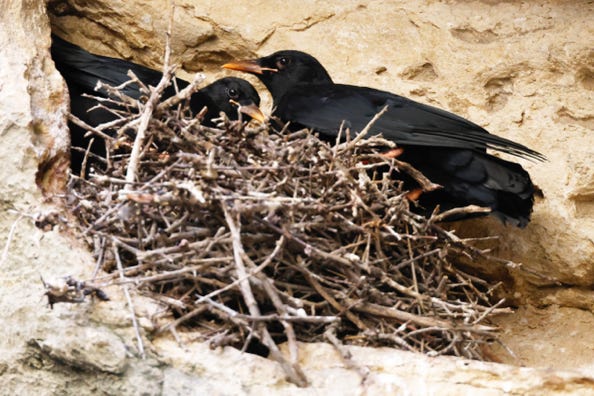
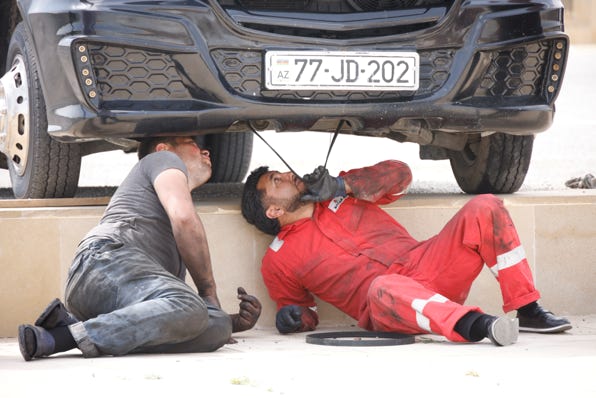
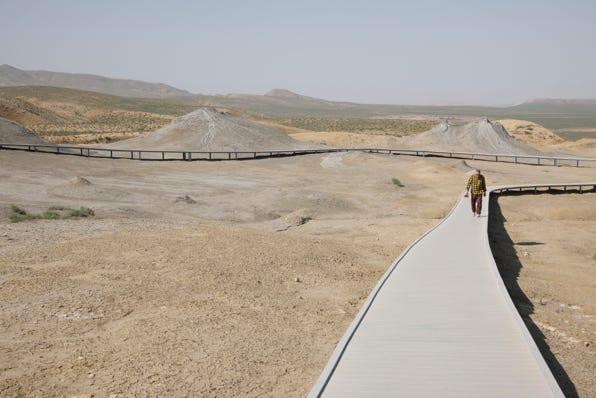
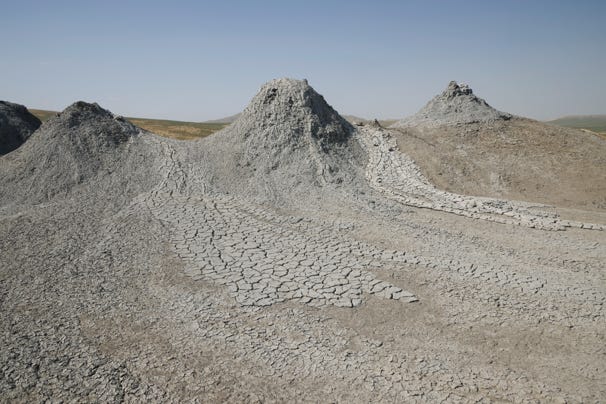
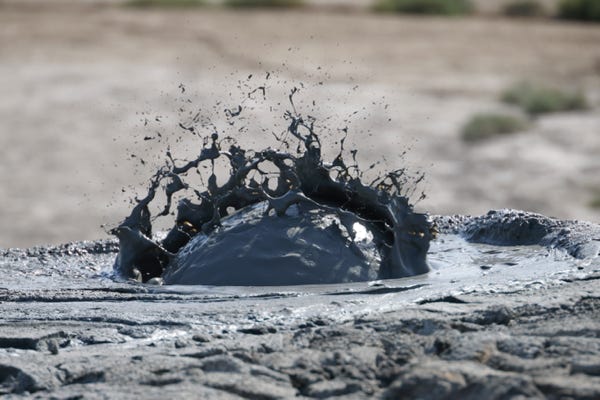
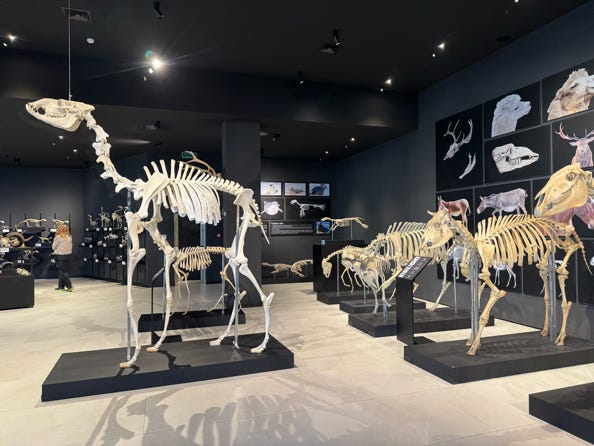
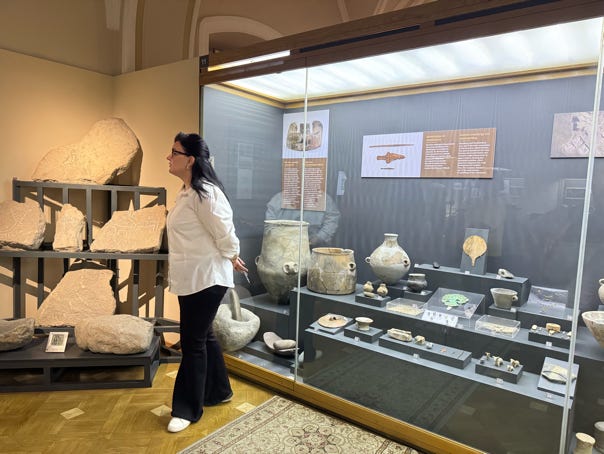
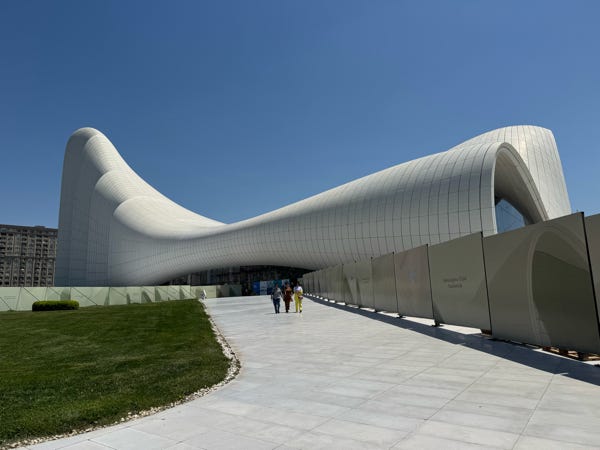
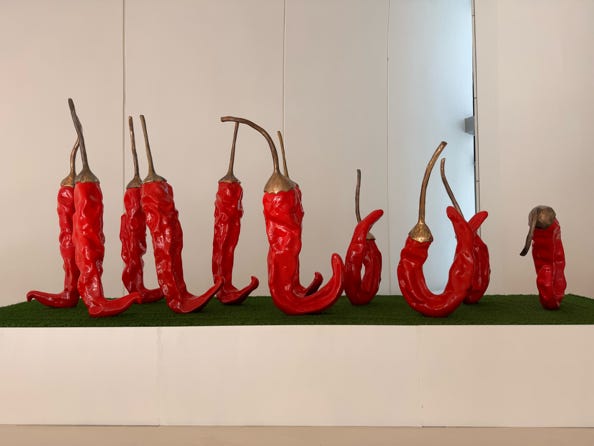
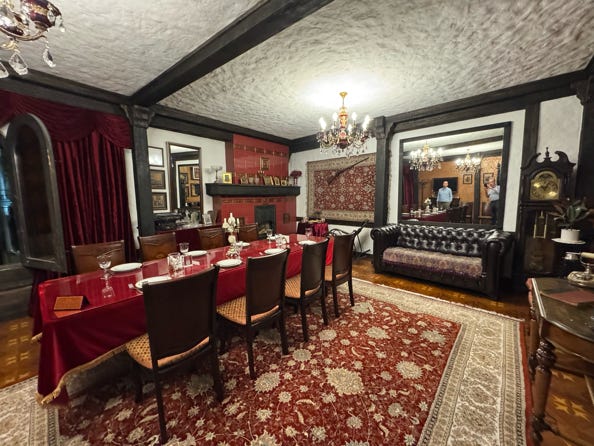
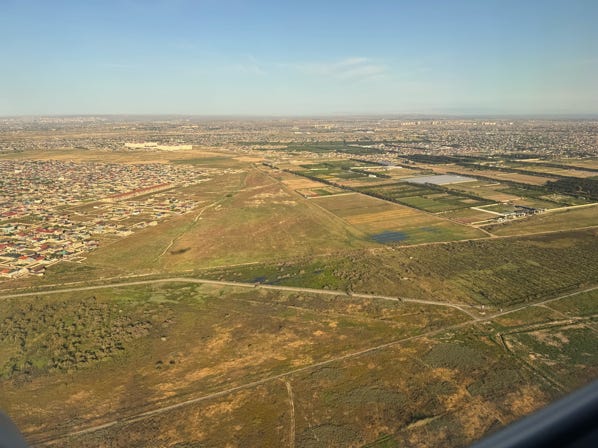
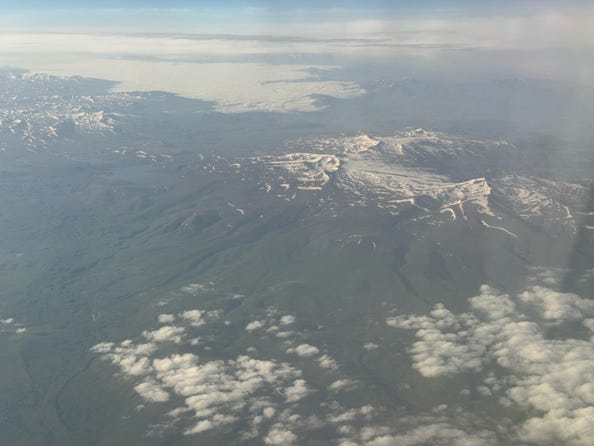
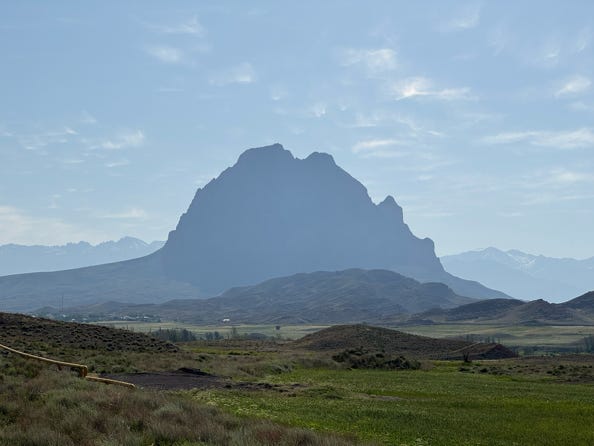
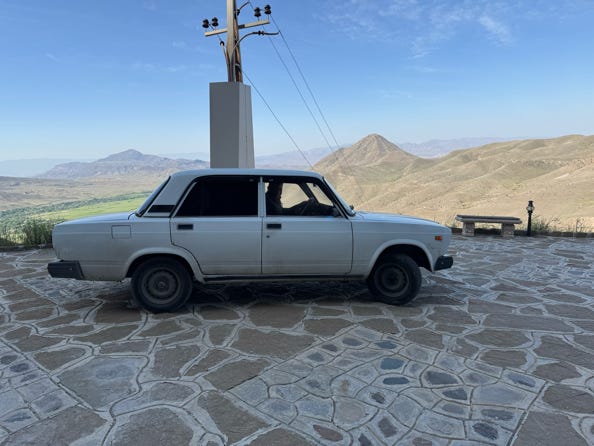
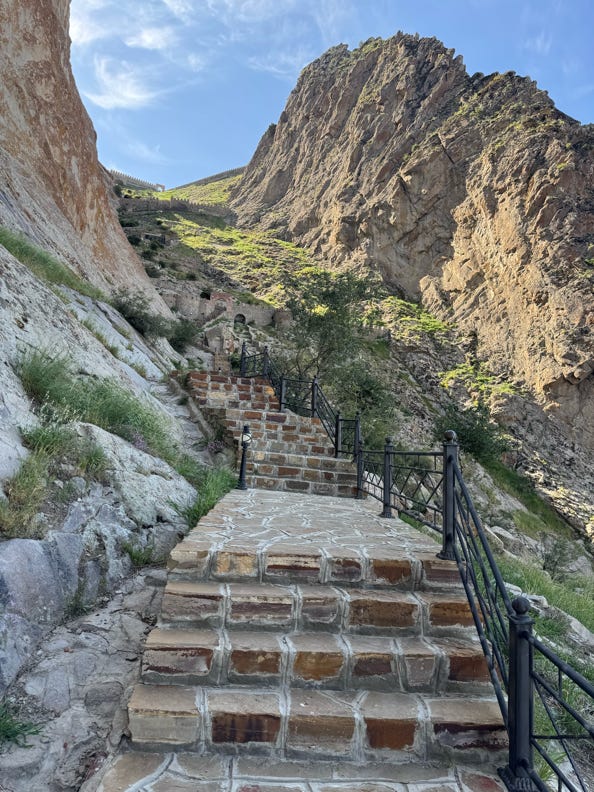
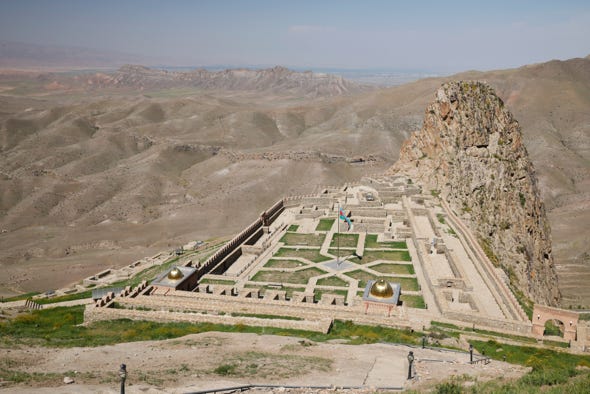
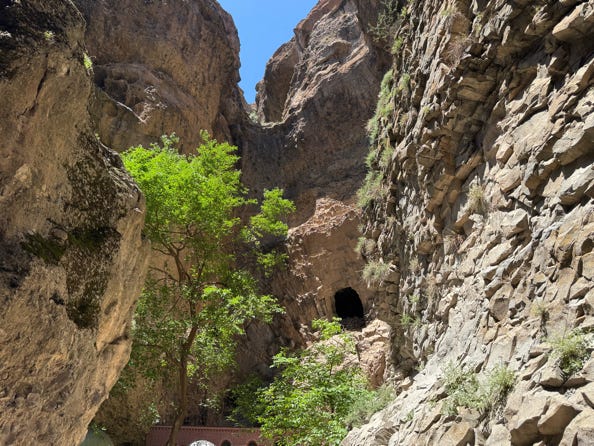
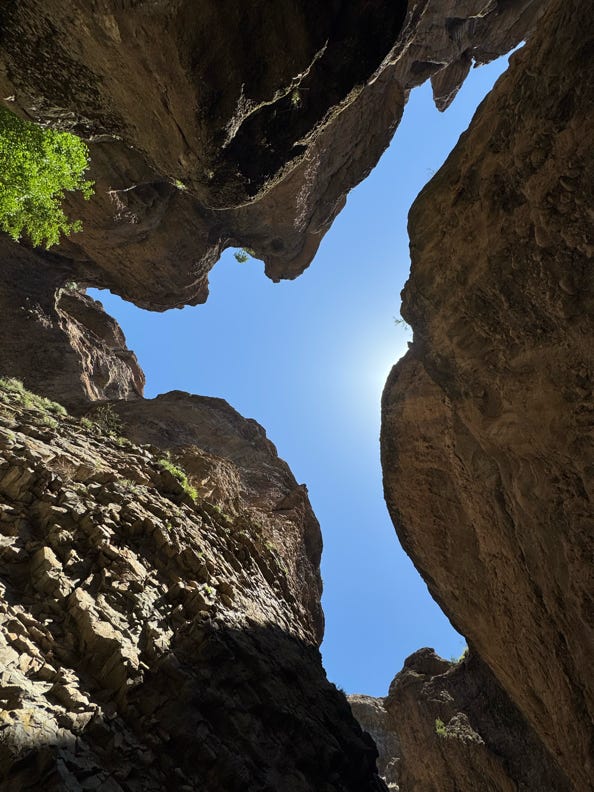
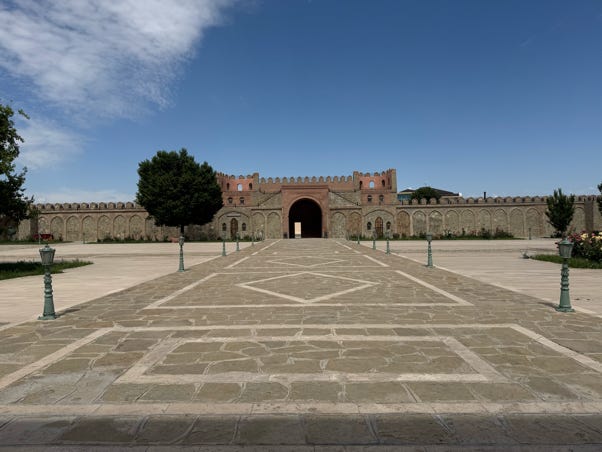
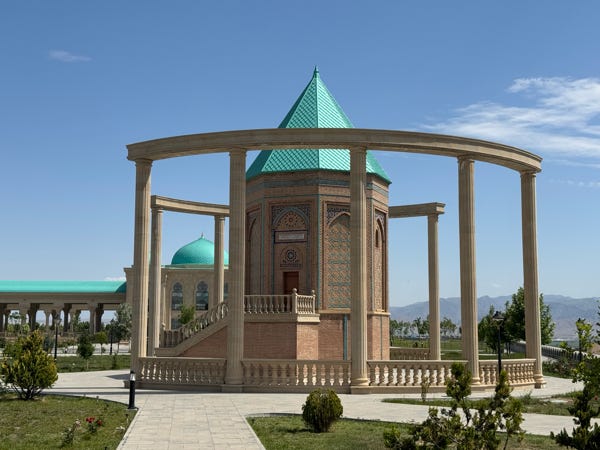
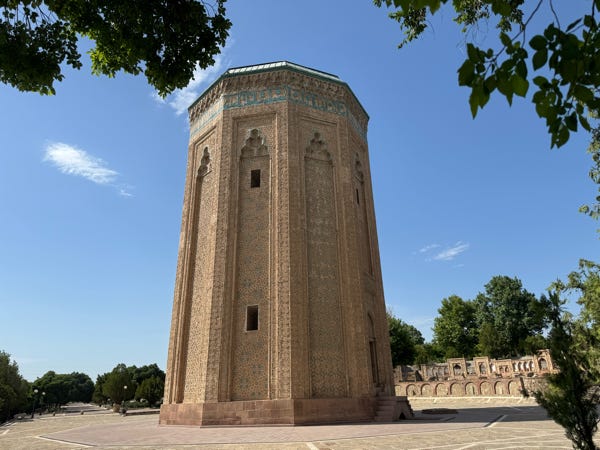
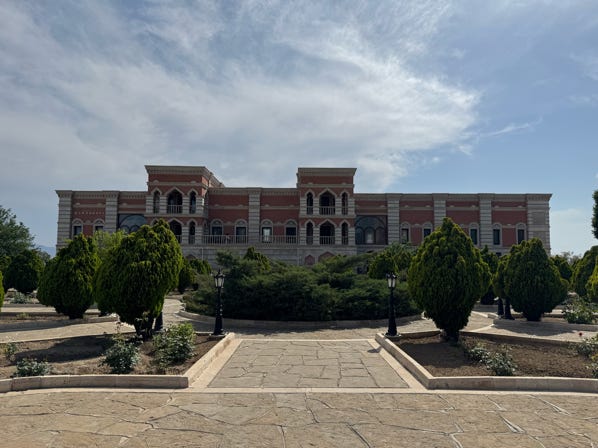
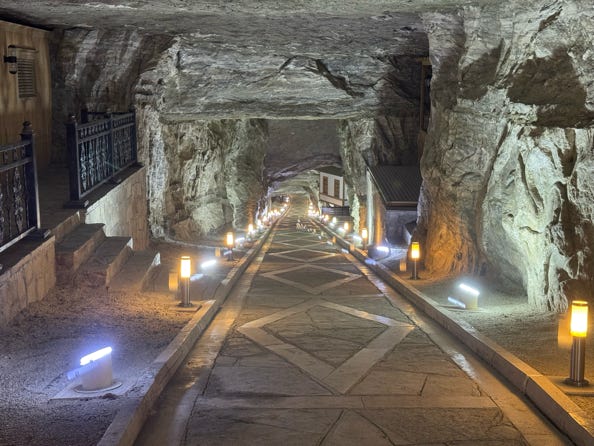
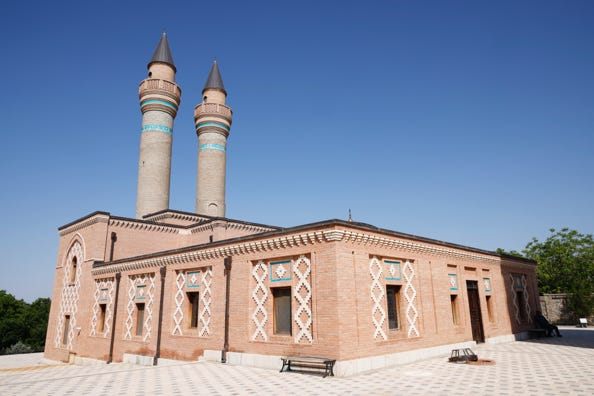
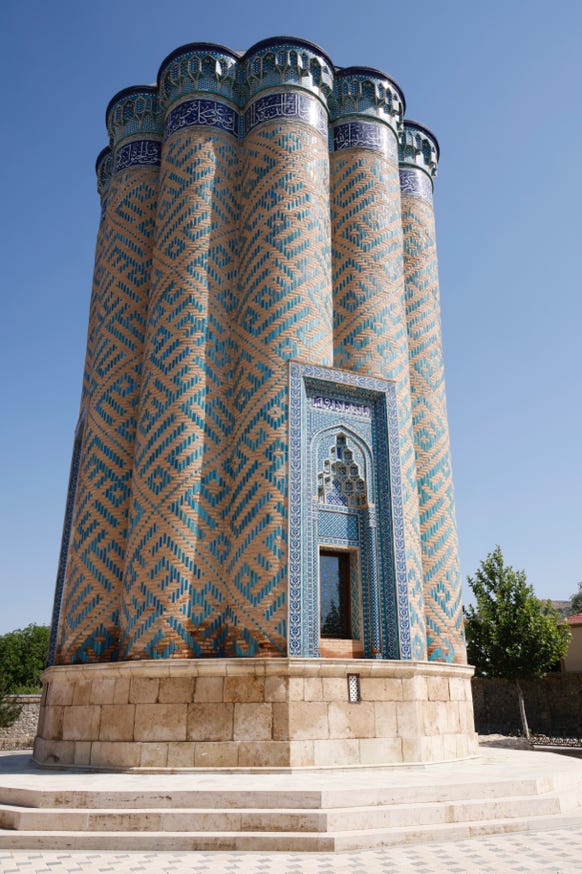
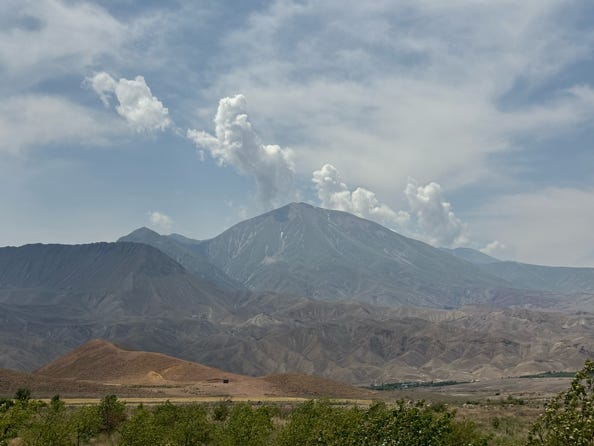
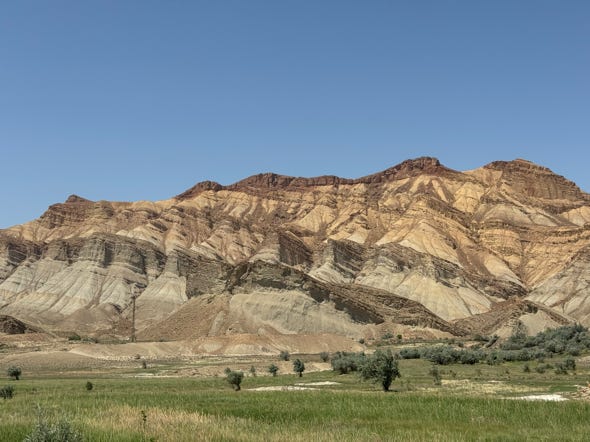
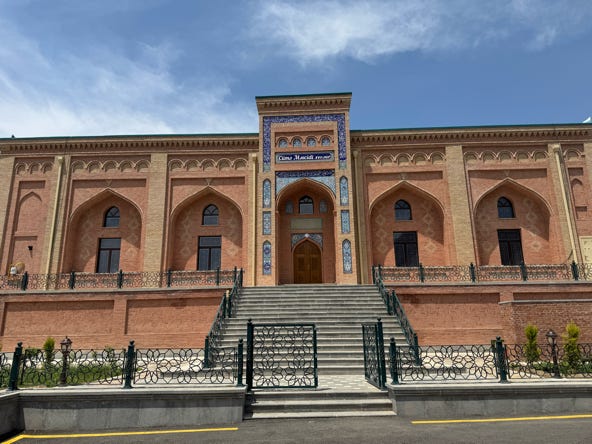
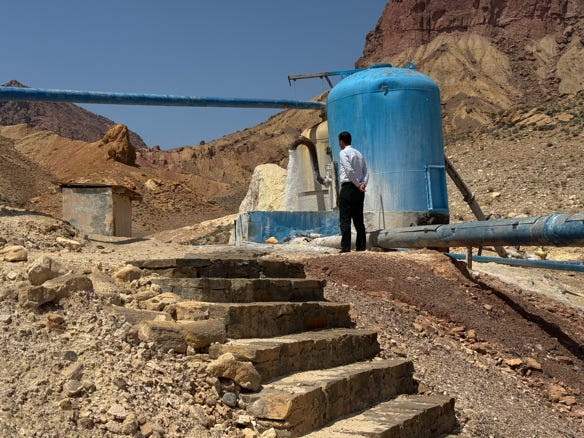
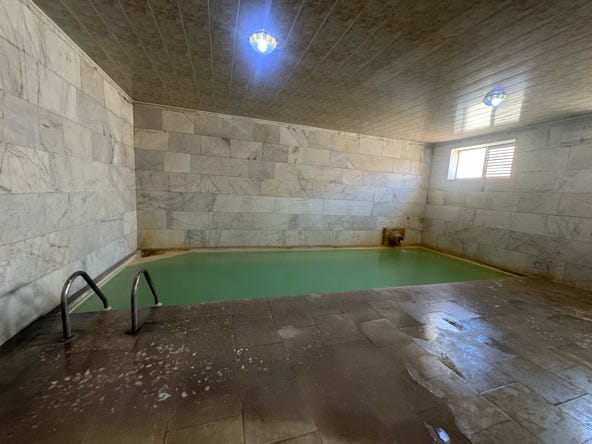
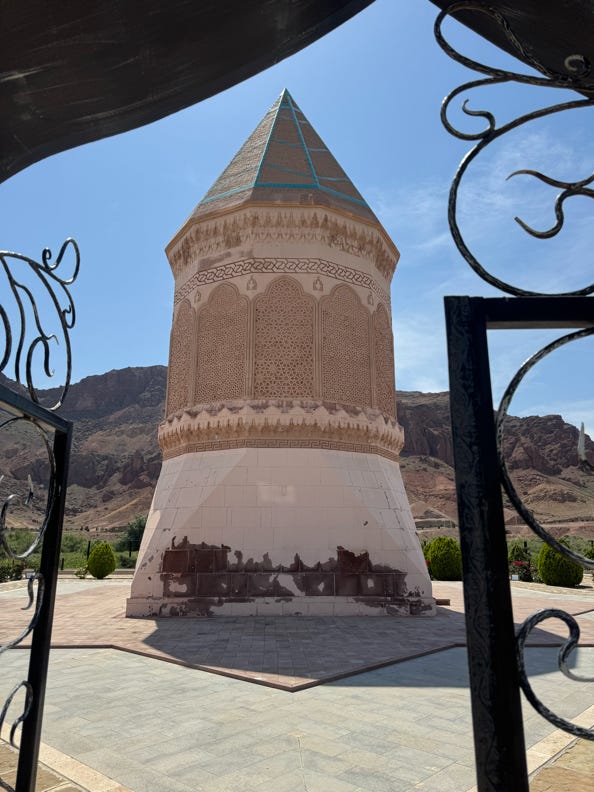
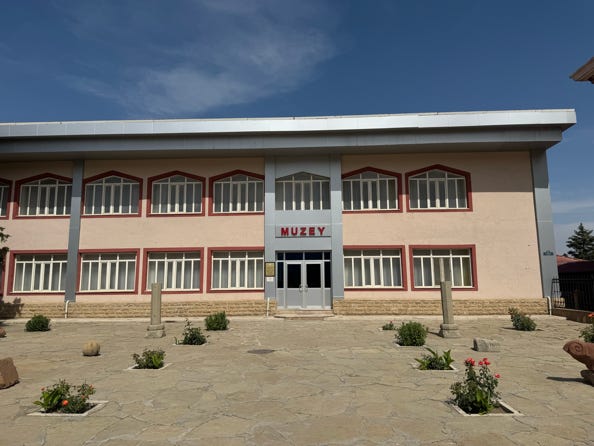
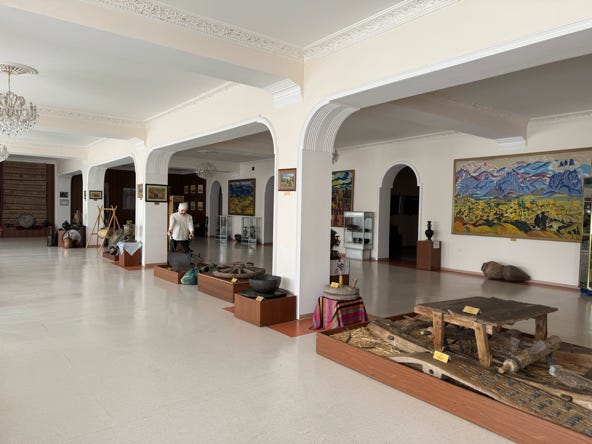
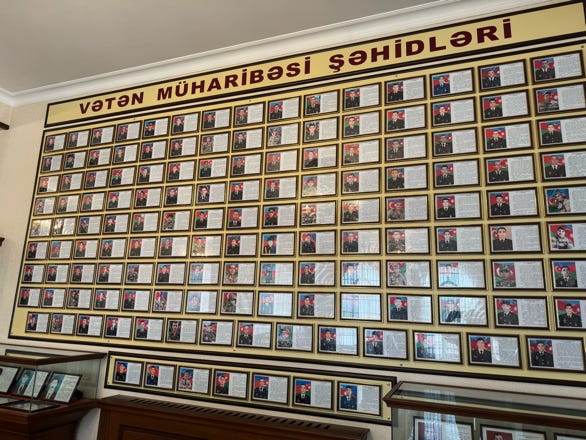
If you’ve enjoyed reading my travel accounts, you might enjoy reading my books! The first novel in my ‘Penny White’ fantasy series is only 99p for Kindle, free on Kindle Unlimited, and also available in paperback. Click on the image below to be taken to Amazon to buy your copy. My author website can be accessed by clicking here.
